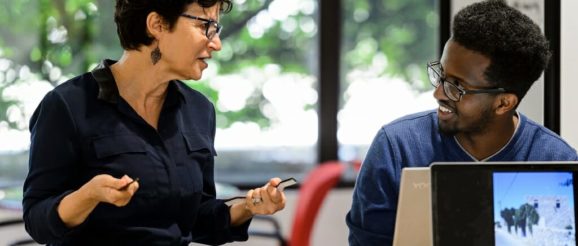New accelerated Master of Science in Design + Innovation engages five disciplines, sparks creativity, excites employers

Undergraduates Montana Hodur, standing, and Rachel Johnson dry-fit fabricated parts for a portable garden prototype. Photo: Jeff Miller
MADISON—The new University of Wisconsin–Madison accelerated Master of Science in Design + Innovation gives new meaning to collaboration. Combining expertise from five schools and colleges with team-based interaction, the program promises to offer students a breadth of highly desired skills.
“The interdisciplinary nature of the program promotes creative thinking and an ability to solve complex problems,” says UW–Madison Chancellor Rebecca Blank. “The program will draw upon top-notch faculty from five disciplines and use our state-of-the-art facilities.”
With applications open now, the MS in Design + Innovation is a 12-month, face-to-face program resulting from a partnership between the College of Engineering, the Wisconsin School of Business, the School of Human Ecology, the Art Department in the School of Education, and the iSchool in the College of Letters and Science. The first cohort will start the program in May 2020.
Students will experience a dynamic course of study to include plenty of time in the UW Makerspace, a place on campus “where limits don’t exist.” A hub for inventing and designing new products, the Makerspace offers an expansive library of technology and equipment along with a lively and welcoming community. Students will also have access to other vibrant labs, studios and entrepreneurial resources across campus.
“Students can come in and dabble in all five areas of study — engineering, business, design, data, and art — but they can also dig deeper in any one of those areas to complement experience they already have,” says Michelle Kwasny, academic director of the MS in Design + Innovation. “We’re looking forward to showing students all the amazing design resources available to them through this program.”
Kwasny says she expects a variety of students to be interested in this new master’s — from software developers and mechanical engineers to artists or musicians, adding, “It’s for people interested in solving complex challenges in a creative way.”
Lesley Sager, faculty associate in Design Studies, talks with undergraduate student Fuad Ahmed about his computer-aided design (CAD) for a portable garden prototype. Photo: Jeff Miller
Core courses of the program include Advanced Design Thinking for Transformation, Tools for Prototyping and Manufacturing, Managing by Design, a data visualization course, and two collaborative capstone courses. Beyond that, students can choose a specialized learning track with depth in areas such as product design, user experience design, communication design, and design strategy to tailor the program to their specific needs and career goals.
Industry leaders are eager to engage with the program and its graduates.
“When evaluating talent for my team, I consider not just the hard skills you can see on a resume, but the soft skills that can only be learned and expressed through hands-on experience working on unpredictable projects in teams,” says Amy Lee, director of design insights & strategy at Delve, a product design and innovation consulting firm. “The UW–Madison MS in Design + Innovation develops both these hard and soft skills to position graduates for success in an ever-changing world.”
Design Studies 341: Design Studies for Transformation, held at Makerspace, is an interdisciplinary, summer-session class that’s a joint venture between the College of Engineering and the School of Human Ecology. Photo: Jeff Miller
According to Burning Glass Labor Insight, more than 25,000 job postings across the nation advertise for people with a master’s degree and skills in design thinking, product design, creative design or interaction design. Kwasny says employers want to be involved in this new master’s program — whether by participating in the program or hiring students.
“The emergence of design as a cross-disciplinary tool is relatively new and rapidly evolving,” says John Zeratsky, best-selling author and entrepreneur. “By creating a completely new program around this emergent need and opportunity, UW–Madison is poised to offer the latest and best thinking on how design can benefit industry and the public sector.”
Chancellor Blank adds, “We know this degree will produce graduates whose training will be in demand by employers in Wisconsin and beyond.”
